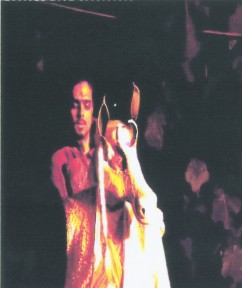 Acting is flirting with schizophrenia – someone said that, I don’t know who, but I believe in that just the way I believe in God. And I believe in God completely; after all God is the ultimate Creator and I believe that as an actor/writer, I am creative!
Acting is flirting with schizophrenia – someone said that, I don’t know who, but I believe in that just the way I believe in God. And I believe in God completely; after all God is the ultimate Creator and I believe that as an actor/writer, I am creative!
How do I give birth to the characters I play? With some help. The first act preceding ‘birth’ is conception and that is taken care of by the writer. The seed of the character is in the play, in the stage directions (of which there should never be many!) and in the dialogues. But that is all black-and-white and two- dimensional – literally. That is where the actor enters…and does not exit until the curtain falls, show after show, sometimes for years, keeping a paper-person alive by giving it throbbing flesh and blood, guts and gore, intellect and feeling. In other words the actor is the mother of each of the characters she plays. The actor goes through the labour pains in an actual, physical process of birthing, of creation.
And then there is both death and resurrection. But that is another story altogether.
Eight years ago, a first time playwright came to me with a script titled Whatever You Say and wanted to cast me in it. Up until then, I had mostly done Hindi theatre and so was happy to be offered a play in English. The fact that this child proposed to produce and direct it herself and open the play at the prestigious Prithvi Theatre Festival in Mumbai, made it effortlessly easy to say ‘yes’. By agreeing to be a part of it, I opened myself to one of the best experiences of my life. I met Tom Alter, a person of immense talent and generosity, who was to be my co-actor and watched a ‘Theatrician’ come into being in the journey that was uniquely that of its writer, producer and director, Shivani Tibrewala.
I opened another play at the same festival, this one in Hindi, written by Makrand Deshpande, a playwright and theatre genius, which was ‘loosely’, a mythological. So on the average day, for about a month or more, I would dash from long rehearsals of an English play, set in urban India, where the two characters in the play became pigeons at the drop of a hat (!) to endless rehearsals of a Hindi play set in a forest in ‘mythological times’, where I played a Princess-warrior who kills her lover to release him from this life and ultimately exchanges her soul with a mare in order to unite with him forever. These were very schizophrenic times indeed!
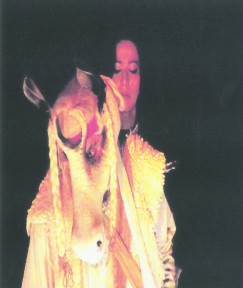 I am told, I displayed severe personality disorders at that time and I know that this is true. Clinical check-ups would have certified me as a lunatic but as an actress I was alive and well. I dropped about 10 kgs and was the leanest I have ever been.
I am told, I displayed severe personality disorders at that time and I know that this is true. Clinical check-ups would have certified me as a lunatic but as an actress I was alive and well. I dropped about 10 kgs and was the leanest I have ever been.
For the Hindi play, I learnt a Manipuri martial art-form known as Thang-tha, along with the chorus and learnt to express my emotions to the back-ground accompaniment of a male voice singing Hindustani classical bandishes since my character had about six dialogues through the entire play yet had to express a gamut of emotions without words! The masterful stroke of the male classical singer’s voice came from the play’s director, Teddy Maurya who is also the most accomplished visual designer/director that I have ever had the privilege of working with on stage. That fabulous play was titled Ashwa- Vishwa.
During the day, which is when most of the rehearsals for Whatever You Say took place, I was required to be X, the bored ‘better-half’ of Y, played by Tom Alter. We represented a couple who had run out of things to say to each other. Monitoring the two and their thoughts was Z, the thought-collector. Now Z has always been troublesome! The actors who have played this character have never been very restful nor have they lasted, sometimes changing from show to show. Presently, Z is being played by the director herself. X and Y though, have lasted through the journey and have aged wonderfully, though they have little to say to each other, considering how much they talk while on stage!
My memory of this time is one of great and endlessly self-replenishing energy. I was soothed by Tom’s presence because we found a synergy that our director never understood then. We confounded her when we took her text and turned it on its head and I often found myself fighting impatience, waiting for her to catch up with us emotionally. Because actors ‘live’ the part on a heartbeat-level, it is usually difficult to understand where they have reached in their ‘feel’ of it, unless a simultaneous emotional plug-in is achieved, by all those participating in the rehearsals. This can be frustrating for those who lag behind and take time to catch up and for those who have surged ahead emotionally. But without this lag and catch-up ‘game’ the process would be empty.
I had trouble understanding X because she was so cold and yet had the seeds of such passion. Personally, I am all passion, I think, but as an actress I must first find the ‘mind’ of the character and then approach her ‘heart’ otherwise the character would end up in a muddle through me. Other actors may approach their roles differently and certainly, I have a completely different methodology when working in front of the camera. Also, X spoke in English which is not the language I think in, so it was a bit of a struggle.
Every evening and late into the night, Princess Kangshini of Ashwa-Vishwas gave me courage because I understood her instinctively. She was a physical creature with a love as thick as coagulating blood for all those she let into her heart. That included her father and her lover and the mare her lover shared his identity and destiny with. However, she was not easy to master physically. Nothing in my urban adulthood had prepared me for the body she possessed and so I had to go through immense pain and practice to create a body she could inhabit without finding it laughable and perhaps even an insult! Then there was the comfort of not needing words for expression! Aah! That is such joy! When your eyes and limbs and breath can do all the talking, as you create sub-sonic air-waves, through your feelings alone, carrying meaning with crystal clarity on a pulse that automatically resonates in every heart present!
Some days Kangshini remained with me all night and walked into the rehearsal of Whatever You Say with the grace and menace of a warrior princess and messed up X so thoroughly that Tom would look at me with tolerant but pointed surprise and the writer/director, Shivani, would despair at the eventual outcome of her precious first-born play. I fought a fierce battle to purge myself of Kangshini’s phantom through most of such afflicted rehearsals and when finally she would leave and X would emerge, it would be time to wrap-up. That was never the end of it though, for now, X, hurt at not having had her place in the sun for so long, would thumb her nose at Kangshini and ruin most of the rehearsal of Ashwa-Vishwa which had a large cast comprising four principal characters and a chorus of 20, resulting in fierce fights and occasionally, walk-outs by various cast-members. In frustration, I ended up rehearsing for 12 to 18 hours a day between the two plays and it was a relief when opening night ‘dawned’ for each of them in turn.
Whatever You Say opened at the Prithvi Theatre, that hallowed stage, blessed by the ghosts of great theatrical talents, both living and dead. There never has been, and there never can be, another show like that first one there. There have been shows of this play in many different venues and all kinds of spaces but that first show, it was blessed by the Gods, one and all, and flew on the wings of the pigeons we played on stage. Sitting on that sacred scaffold above that stage, being a pigeon in one of the scenes, is a privilege not offered to many actors but Tom and I can proudly lay claim to it. There is a great professional love-story which began that day between Tom and I. It continues to this day and somewhere in that space there is also Shivani.
Ashwa-Vishwa opened at the out-door venue of the Festival, the Horniman Circle Gardens in Mumbai, on a stage designed and created by that great theatrical genius, Teddy Maurya, to an over-flowing audience which also comprised of my erstwhile pigeon-mate, Tom. I will never forget this play that forced me to find the body and soul of a warrior; that dared to have a man play a mare and gave a princess the voice of a male singer. It was erotic and terrible, tragic and uplifting, silent and vocal at the same time. And Teddy is entwined in my life the way images and colours are entwined in each other.
Tom said to me at the end of the show, “My goodness, you were going to this play after Whatever You Say everyday?! No wonder you were the way you were during that time!”
From a pigeon on human-wings to a princess whose soul refused to fly – this was Birth. There is also Death and Resurrection. But like I said, that’s another story.






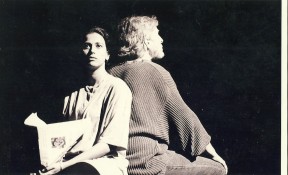
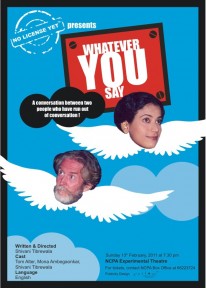
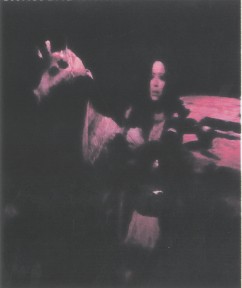
Great piece of writing! I had a peep into the act of creation courtesy Mona.
Thanks for the piece!
Manu